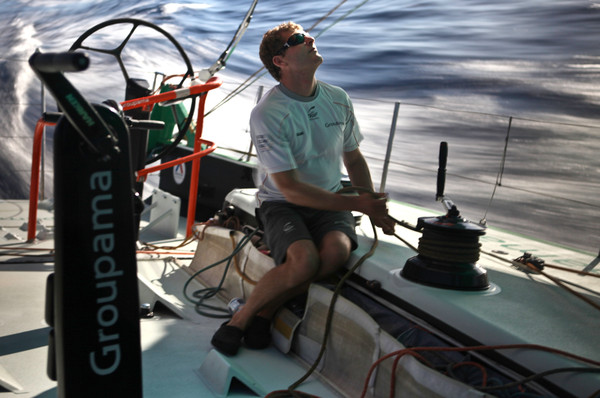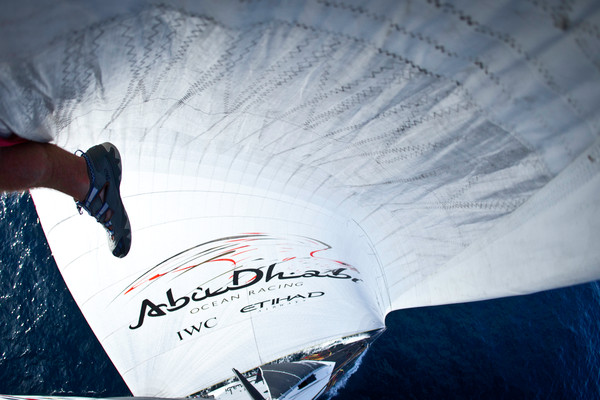
It was crunch time for the Volvo Ocean Race crews on Wednesday as they prepared to punch through a weather front that stands between them and the sought-after trade winds that will catapult them towards Miami.
Whichever team best navigates the light winds of the cold front and reaches the trades first will hold a huge advantage over their rivals as they rocket north at speeds of more than 20 knots — and any losses made over the initial days of Leg 6 will become brutally clear.
After overhauling CAMPER and Abu Dhabi as they struggled in lighter airs overnight, PUMA Ocean Racing powered by BERG looked strongest as the fleet approached the front currently blocking their path.
But with Telefónica and Groupama shaving miles off the leaders from their more offshore position, the pressure was on to get through as quickly as possible without losing miles to any other team.

“Today’s the big day really,” said PUMA navigator Tom Addis. “The first boat into the trades has a pretty major advantage — you can extend for quite a long time and be quite hard to catch.
“This is the critical one. Some points on some race tracks aren’t critical, but this one is critical.”
With the front around 60 miles ahead, the teams were ploughing all their resources into working out the best line to take through its light, fluky winds.
“I spent a lot of last night working on our approach for this stuff,” Addis added. “We’re happy with our position and if we’re in the lead our chances [of reaching the trades first] are something more than 50 per cent.
“But we’re leading into some light stuff and there will be some pressure from behind so we’ll just try and do the best we can and be the first one out. It’s important to be the first one out.”
Meanwhile, Franck Cammas’ men on fifth-placed Groupama sailing team were doing their best to hang on to Telefónica in conditions that seemed to favour the overall race leaders.

“We are more used to being the hunted rather than the hunters,” said Groupama navigator Jean-Luc Nélias. “In general, we’ve been on the same option as Telefónica and they’ve always been a bit faster than us.
“We’re investigating — we’re looking below the hull, we’re looking at the daggerboards, checking if there is some seaweed or plastic stuck on them, but the conclusion right now is that we are a bit behind.”
However with the cold front transition zone immanent, Nélias said there were plenty of opportunities to pass their rivals up ahead.
“It’s a bit like the Doldrums,” he added. “It’s so hazardous and complicated that it’s not always the first to enter it who leaves it first.”
Volvo Ocean Race chief meteorologist Gonzalo Infante said the cold front was narrower in the east, ahead of Telefónica and Groupama, and wider in the west in front of CAMPER with Emirates Team New Zealand and Abu Dhabi Ocean Racing.
“All the hard work of the first four days comes down to this,” Infante said. “It’s a super critical moment. The teams have an opportunity to capitalise on their position by entering the trades first.”
The dilemma could force CAMPER and Abu Dhabi to head offshore from their current positions around 90 miles off the coast of Brazil, costing them precious miles.
CAMPER were dealt a blow overnight when a rope securing the foresail to the bow of their yacht snapped.
“Luckily everyone was ok and time wise it probably only cost us a minute or two so we are very fortunate,” said skipper Chris Nicholson.
On board Abu Dhabi, the crew were preparing for the demanding day ahead as they closed in on their rivals.
“Things remain tight with CAMPER and we are slowly converging with the Juan K boats,” helmsman Rob Greenhalgh said. “There are a few lightning storms up ahead, so it looks like we are approaching the frontal line. It should be an interesting next 24 hours.”
The first boats are expected to cross the Leg 6 finish line in Miami around May 7.
Leg 6
25/04/2012 13:03:02 UTC
DTL DTLC BS DTF
1 PUMA 0.00 0 10.8 4035.8
2 CMPR 5.70 2 13.4 4041.4
3 ADOR 12.10 1 13.3 4047.9
4 TELE 21.10 0 13.3 4056.9
5 GPMA 37.90 5 13.8 4073.7
– SNYA Did Not Start
